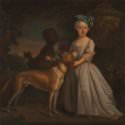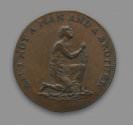Elihu Yale Sundial

[Unknown artist], Elihu Yale Sundial[Unknown artist], Elihu Yale Sundial. Yale University Art Gallery; Gift of Ganson G. Depew, B.A. 1919, Clarence W. Bowen, B.A. 1873, Henry King Smith, B.A. 1898, E. Byrne Hackett, Hon. M.A. 1914, and R. Eden Dickson, Esq.
Elihu Yale Sundial
ca. 1708
Unknown artist
Bronze, cast lead, and cement
base: 32.39 x 49.53 x 49.53 cm (12 3/4 x 19 1/2 x 19 1/2 in.), overall: 161.29 x 84.46 x 68.26 cm (63 1/2 x 33 1/4 x 26 7/8 in.)
This sundial is believed to have stood on Elihu Yale’s estate, Plas Grono, near Wrexham, in Wales. The bronze dial, which bears Yale’s coat of arms, is supported by the figure of a kneeling man cast in lead. This is one of many similar sundials produced chiefly by the sculptors John Nost and John Cheere to ornament English gardens in the early eighteenth century. Nost made the first of these for King William III’s Privy Garden at Hampton Court. In the eighteenth century, the figure represented here was commonly
described as a “Blackamoor,” an “African,” or a “slave.” As these terms suggest, this depiction builds upon—and fuses together—several iconographic traditions: first, Renaissance and Baroque images of kneeling, subjugated slaves; and second, allegorical depictions of Africa as one of the “Four Continents." The popularity of sculptures like this one coincided with the dramatic expansion of Britain’s slave empire, which relied on African labor in the Americas.
In 1922, this sundial was given to Yale University, and it stood in the courtyard of Jonathan Edwards College from 1933 until the 1970s. The graffiti visible on its surface probably dates from this period.
1922.8
Inscribed with modern graffiti



![Elihu Yale, the second Duke of Devonshire, Lord James Cavendish, Mr. Tunstal, and a Page (Yale Center for British Art, Gift of Andrew Cavendish, eleventh Duke of Devonshire) [Unknown artist], group portrait featuring Elihu Yale (YCBA)](https://interactive.britishart.yale.edu/sites/default/files/styles/ycba_thumbnail/public/Elihu%20Yale%20%28YCBA%29_0.jpg?itok=wOXprlA4)